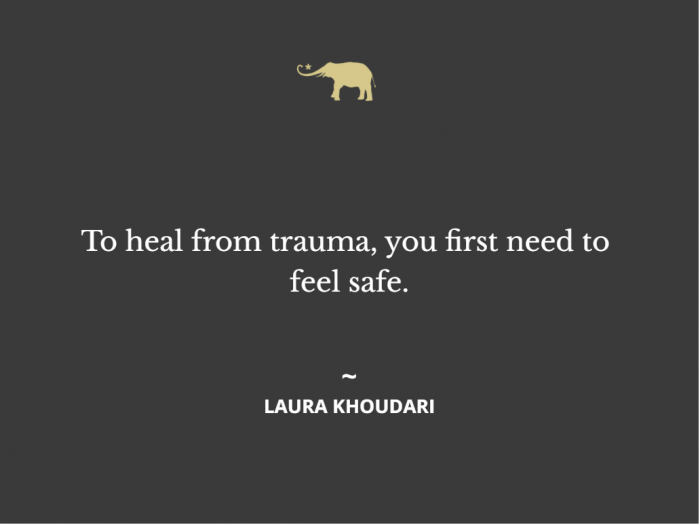To heal from trauma, we first need to feel safe.
Feeling protected from danger and risk creates the space we need to think clearly, assess what’s around us, and take intentional action.
The reason for this comes down to human biology: when we feel safe, our prefrontal cortex—the part of our brain that integrates thoughts, feelings, and basic biological functions—comes online, fastidiously processing and whirring away. Yet the minute a threat enters the picture, the brain’s limbic system takes over.
This emotional and survivalist part of the brain is no longer connected to the part of our brain that makes maps of the world and controls higher-level thinking. In this limbic state, we react rather than act, drawing from emotional memory rather than new, vital information.
Now, our limbic system is amazing when we encounter a bear or have to jump out of the way of a speeding car. But when we’re deep in the process of healing work—whether it’s a talk-based, writing-based, or body-based healing practice—it’s important to be able to integrate all parts of our past and present experiences. We need our prefrontal cortex to be online.
As a movement-based trauma practitioner who combines Somatic Experiencing (SE) and strength training, one of my priorities when working with new clients is giving them tools to feel safe in their bodies and assess the safety of the environments they’re in. One tool I rely on for both is known as “orienting.”
What is orienting?
We orient to a space through our senses. As we read this, many of our neurons, which are part of our nervous system, are taking information gathered by our eyes, nose, mouth, skin, and ears, and sending it to our brain for processing. Our brain then sends commands, via other neurons, to all of our body’s systems, telling them how to respond. So, if someone throws a basketball our way, we see it, and based on our past experiences and new information (the ball is coming at us, and no one else is near us on the court!), we quickly respond.
We might be wondering what orienting has to do with transforming spaces—such as our therapist’s office, living room, yoga studio, or barbell club—into safe and healing spaces. Although orienting in response to a novel stimulus is an instinctual response, we can intentionally orient to any space to evaluate and promote its sense of safety. Orienting with intention engages the map-making part of our brain so we can integrate all available information.
How to orient to your space and healing practice
Before you engage in your next healing practice, I invite you to orient yourself to the space and the practice itself. Start by looking around and noticing where things are. If your practice is at home, survey your space, whether it’s a small studio or a house with a garage and an extra room. Think about which part of the space best meets your needs. Do you need zero clutter, total privacy, or proximity to a Wi-Fi router? Get to know this space in the context of engaging in healing work.
When you choose somewhere to practice, be intentional about picking a place to store any equipment you’ll need as well. Have a plan for setting up and putting away equipment if the space is multipurpose or shared with others.
If your healing practice takes you to any sort of wellness center or office, take a moment to get to know where a few things are: equipment, bathrooms, and a place to leave your stuff. If it’s a larger space, like a gym, you might ask to be shown around. Or you might investigate yourself. Either works, but start to make a mental map of the place.
I also suggest that you orient yourself to your healing practice—every time. By that, I mean considering what form your practice is going to take. For example, if you attend a meditation class, chances are it will have a general framework. Before class, while everyone is setting up, you might ask the instructor or someone who has taken the class before about its format.
If you’re doing healing work on your own, a journal can come in handy. Not only can you use it to track work but also to plan what you’re going to do next. If you’re following a program, transcribe it into your journal or a format that works well for you. I find that transcribing programs into my own training journal helps my practice “stick.” Knowing the plan is a way to orient to your practice on a daily basis.
When you know you’re safe but don’t feel that way
Sometimes, you may rationally know that you’re safe, but it feels like you aren’t. This can come up in therapy, in the gym, or even in the privacy of your own home. Memories can trigger the same feelings and sensations you had at the time of your trauma and make you feel unsafe or in danger.
Using orienting techniques, you can assess the accuracy of these feelings and be better equipped to leave the environment if ill feelings remain. By creating an opportunity for your senses to tell your brain where you are, what’s going on, and how safe it is, you’re empowering yourself to be present, and you’re giving your prefrontal cortex the nudge it needs to come online.
You can orient using any of your senses, but I find sight and sound to be the most accessible.
Try these two exercises:
1. Five Things.
Orienting with sight using “Five Things” is particularly useful when we need to quickly come back to the here and now. I use this technique a lot in therapy and when I’ve been overwhelmed in public spaces. This is also a great regulating technique to use with kids because it can become playful.
>> Look around for five blue things. Look not just in front of you, but to the left and right, behind you, above you, and below you. As you see them, name them.
>> Repeat, but this time look for five yellow things.
>> Repeat, but this time look for five red things.
>> Repeat as needed with different colors until you feel grounded in the present.
2. Sounds near to far.
At the end of my training sessions and other healing work, I bring my attention from the world inside me to the world around me using this ritual.
>> Sit or stand with a soft, downturned gaze, looking at nothing in particular, or with your eyes closed. Listen to your own sounds: your breath, your stomach gurgles, the sound as you swallow.
>> Now listen to the sounds that surround you. This could be the creaking of the building or someone shuffling papers nearby. Where are these sounds in relation to you?
>> Next, listen to sounds even further away—from outside of the building you’re in. What do they tell you about what’s going on outside? Perhaps it’s raining or windy, or you’re reminded that you’re in the middle of a busy city.
>> When you’re ready, open your eyes or lift your gaze and take in the space around you.
Orienting yourself to a space through your senses creates a safe container in which you can more fully connect with new experiences, deal with the mundanities of everyday life, and do the hard work of healing. It’s an incredibly simple yet powerful tool.
~


 Share on bsky
Share on bsky





Read 0 comments and reply